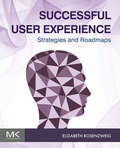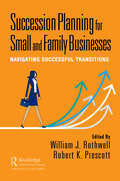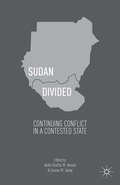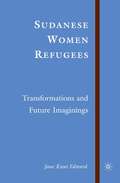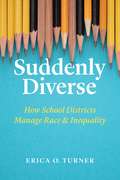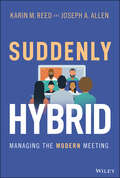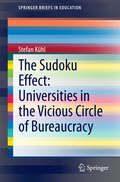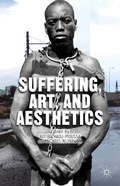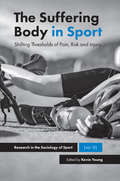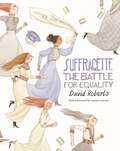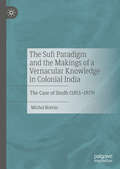- Table View
- List View
Successful User Experience: Strategies and Roadmaps
by Elizabeth RosenzweigSuccessful User Experience: Strategy and Roadmaps provides you with a hands-on guide for pulling all of the User Experience (UX) pieces together to create a strategy that includes tactics, tools, and methodologies. Leveraging material honed in user experience courses and over 25 years in the field, the author explains the value of strategic models to refine goals against available data and resources. You will learn how to think about UX from a high level, design the UX while setting goals for a product or project, and how to turn that into concrete actionable steps. After reading this book, you’ll understand: How to bring high-level planning into concrete actionable stepsHow Design Thinking relates to creating a good UXHow to set UX Goals for a product or project How to decide which tool or methodology to use at what point in product lifecycle This book takes UX acceptance as a point of departure, and builds on it with actionable steps and case studies to develop a complete strategy, from the big picture of product design, development and commercialization, to how UX can help create stronger products. This is a must-have book for your complete UX library.Uses strategic models that focus product design and development Teaches how to decipher what tool or methodology is right for a given moment, project, or a specific teamPresents tactics on how to understand how to connect the dots between tools, data, and design Provides actionable steps and case studies that help users develop a complete strategy, from the big picture of product design, development, and commercialization, to how UX can help create stronger productsCase studies in each chapter to aid learning
Succession Planning for Small and Family Businesses: Navigating Successful Transitions
by William J. Rothwell Robert K. PrescottWho will lead your organization into the future? Have you created the systems to properly implement required succession transitions? Have you put the financial tools in place to fund the transition? Do you want a plan that connects with your personal and company core values? When do you include timely planning related to strategy and talent issues? What are the appropriate communication strategies for sharing your plan? What legal issues need consideration related to the strategy, financial, and people aspects of succession? So, what is preventing you from starting this effort tomorrow? Small and family businesses are the bedrock of all businesses. More people are employed by small and family-owned businesses than by all multinational companies combined. Yet the research on small and family businesses is bleak: fewer than one-third of small business owners in the United States can afford to retire. Only 40% of small businesses have a workable disaster plan in case of the sudden death or disability of the owner, and only 42% of small businesses in the United States have a succession plan. Fewer than 11% of family-owned businesses make it to the third generation beyond the founder. Lack of succession planning is the second most common reason for small business failure. Many organizations often wonder where to start and what to do. Succession Planning for Small and Family Businesses: Navigating Successful Transitions presents a comprehensive approach to guiding such efforts. Small and family-owned businesses rarely employ first-rate, well-qualified talent in human resources. More typically, business owners must be jacks-of-all-trades and serve as their own accountants, lawyers, business consultants, marketing experts, and HR wizards. Unfortunately, that does not always work well when business owners embark on planning for retirement or business exits. To help business owners avert problems, this book advises on some of the management, tax and financial, legal, and psychological issues that should be considered when planning retirement or other exits from the business. This comprehensive approach is unique when compared to the books, articles, and other literature that currently exist on the market. This book takes on a bold and integrated approach. Relevant research combined with the rich experiences of the authors connects this thorough, evidence-based approach to action-based approaches for the reader.
Succession Planning for Small and Family Businesses: Navigating Successful Transitions
by William J. Rothwell and Robert K. PrescottWho will lead your organization into the future? Have you created the systems to properly implement required succession transitions? Have you put the financial tools in place to fund the transition? Do you want a plan that connects with your personal and company core values? When do you include timely planning related to strategy and talent issues? What are the appropriate communication strategies for sharing your plan? What legal issues need consideration related to the strategy, financial, and people aspects of succession? So, what is preventing you from starting this effort tomorrow? Small and family businesses are the bedrock of all businesses. More people are employed by small and family-owned businesses than by all multinational companies combined. Yet the research on small and family businesses is bleak: fewer than one-third of small business owners in the United States can afford to retire. Only 40% of small businesses have a workable disaster plan in case of the sudden death or disability of the owner, and only 42% of small businesses in the United States have a succession plan. Fewer than 11% of family-owned businesses make it to the third generation beyond the founder. Lack of succession planning is the second most common reason for small business failure. Many organizations often wonder where to start and what to do. Succession Planning for Small and Family Businesses: Navigating Successful Transitions presents a comprehensive approach to guiding such efforts. Small and family-owned businesses rarely employ first-rate, well-qualified talent in human resources. More typically, business owners must be jacks-of-all-trades and serve as their own accountants, lawyers, business consultants, marketing experts, and HR wizards. Unfortunately, that does not always work well when business owners embark on planning for retirement or business exits. To help business owners avert problems, this book advises on some of the management, tax and financial, legal, and psychological issues that should be considered when planning retirement or other exits from the business. This comprehensive approach is unique when compared to the books, articles, and other literature that currently exist on the market. This book takes on a bold and integrated approach. Relevant research combined with the rich experiences of the authors connects this thorough, evidence-based approach to action-based approaches for the reader.
Suchmaschinen verstehen (Xpert.press)
by Dirk LewandowskiSuchmaschinen sind heute die wichtigsten Werkzeuge, um an Informationen zu gelangen. Wir verwenden Suchmaschinen täglich, meist ohne weiter darüber nachzudenken. Doch wie funktionieren diese Suchwerkzeuge eigentlich genau? Das Buch betrachtet Suchmaschinen aus vier Perspektiven: Technik, Nutzung, Recherche und gesellschaftliche Bedeutung. Es bietet eine klar strukturierte und verständliche Einführung in die Thematik. Zahlreiche Abbildungen erlauben eine schnelle Erfassung des Stoffs.Neben einer ausführlichen Darstellung der in den bekannten Suchmaschinen verwendeten Rankingverfahren wird auch ausführlich auf das Nutzerverhalten eingegangen, das wiederum die Ergebnisdarstellung prägt. Dazu kommen grundlegende Betrachtungen des Suchmaschinenmarktes, der Bedeutung der Suchmaschinenoptimierung und der Rolle der Suchmaschinen als technische Informationsvermittler. Das Buch richtet sich an alle, die mit Suchmaschinen zu tun haben und ein umfassendes Verständnis dieser Suchwerkzeuge erlangen wollen, u.a. Suchmaschinenoptimierer, Entwickler, Informationswissenschaftler, Bibliothekare, Rechercheure in Wissenschaft und Praxis sowie Online-Marketing-Verantwortliche.Für die zweite Auflage wurde der Text vollständig überarbeitet. Neben einem neuen Kapitel zur Suchmaschinenwerbung wurden zahlreiche Abschnitte zu neu aufgekommenen Themen hinzugefügt. Alle Statistiken und Quellen wurden auf den neuesten Stand gebracht.Aus Rezensionen zur ersten Auflage:„Dirk Lewandowski bringt den Fachleuten und Laien näher, was im Hintergrund der Suchmaschine abläuft und wie die Suchergebnisse zustande kommen.“ (Stephan Holländer in Password) „Dirk Lewandowski [...] hat einerseits das Fachwissen, sowohl in die Tiefe zu gehen als auch die Zusammenhänge so verständlich wie möglich zu behandeln. Ein Glücksfall!“ (Jürgen Plieninger in BuB)
Suchmaschinen verstehen (Xpert.press)
by Dirk LewandowskiDas Buch betrachtet das Thema Suchmaschinen ausgehend von der täglichen Recherche und führt in die technischen Grundlagen, in Recherchetechniken sowie die gesellschaftlichen und wirtschaftlichen Bedingungen der Recherche im Web ein. Suchmaschinen sind heute die wichtigsten Werkzeuge, um an Informationen zu gelangen. Wir verwenden Suchmaschinen täglich, meist ohne weiter darüber nachzudenken. Doch wie funktionieren diese Suchwerkzeuge eigentlich genau?Neben einer ausführlichen Darstellung der in den bekannten Suchmaschinen verwendeten Rankingverfahren wird auch ausführlich auf das Nutzerverhalten eingegangen, das wiederum die Ergebnisdarstellung prägt. Dazu kommen grundlegende Betrachtungen des Suchmaschinenmarkts, der Bedeutung der Suchmaschinenoptimierung und der Rolle der Suchmaschinen als technische Informationsvermittler. Nicht zuletzt wird auch die Seite der Recherche betrachtet und gezeigt, wie man mit den bekannten Suchmaschinen effizient recherchieren kann.Das Buch verhilft allen, die mit Suchmaschinen recherchieren oder sich beruflich mit der Optimierung, Aufbereitung und Sichtbarmachung von Inhalten beschäftigen, zu einem umfassenden Verständnis der Ansätze, Stärken und Schwächen verschiedener Suchmaschinen und der ihnen zugrunde liegenden Technologien.
"Sucht" aus körpersoziologischer Perspektive (Sozialwissenschaftliche Gesundheitsforschung)
by Sophie RubscheitDie vorliegende, qualitative Studie beleuchtet die Wechselwirkungen zwischen Körperwissen und Leiberfahrungen im Hinblick auf Sucht. Die empirischen Ergebnisse zeigen, dass es nicht ausreicht, Sucht lediglich als natürlichen Prozess körperlicher bzw. psychischer Vorgänge zu verstehen. Mindestens ebenso bedeutend für die Entstehung und Aufrechterhaltung von Sucht ist das Setting im Sinne des soziokulturell geprägten Suchtwissens. Ein gesundheitsförderlicher Umgang mit Drogengebraucher*innen muss daher immer auch die Wechselwirkungen zwischen Körper und Gesellschaft in Rechnung stellen und Identifikationsmöglichkeiten jenseits der Sucht ermöglichen.
Sucht und Männlichkeiten: Entwicklungen in Theorie und Praxis der Suchtarbeit (Studien Interdisziplinäre Geschlechterforschung)
by Jutta Jacob Heino StöverBetrachtet man die Epidemiologie zur Verteilung der von psychoaktiven Substanzen abhängigen Menschen in Deutschland, fällt deutlich die vermehrte Betroffenheit bei Männern auf. Gleichzeitig bestehen wenig Versorgungsangebote mit männerspezifischen Ansätzen. Der Zusammenhang von Suchtentwicklung und Männlichkeitskonzepten ist auch wissenschaftlich nur rudimentär ausgearbeitet. Diese Publikation zielt darauf, den Dialog zwischen Wissenschaft und Praxis zu fördern, um zu wissenschaftsgestützten, genderorientierten und lebensweltbezogenen Praxiskonzepten zu gelangen.
Suchtkultur und Gruppentherapie: Vom anonymen Ich zum anonymen Wir
by Paula HelmPaula Helm beschäftigt sich mit den gesellschaftlichen und psycho-sozialen Bedingungen der Suchtgenesung, mit dem kulturellen »Framing« der Sucht und geht der Frage nach, warum suchtkranke Menschen den Schutz der Anonymität brauchen, um sich mit ihren Leiden zu »outen« und sich zu trauen, um Hilfe und Unterstützung bei der Behandlung einer tödlichen Krankheit zu bitten. Die Antworten auf diese Fragen gibt die Autorin auf der Grundlage einer ethnographischen Forschung zu selbstorganisierten Suchttherapiegruppen. Hierbei analysiert sie unveröffentlichte Ego- und Archivdokumente, welche exklusive Einblicke in das emotionale Erleben Suchtkranker gewähren. Die Ergebnisse der interdisziplinären Studie halten uns allen einen Spiegel vor, denn sie weisen die Grenzen eines spätkapitalistischen Hyperindividualismus auf und zeigen, wie tief die Sucht mit den Strukturen westlicher Gesellschaften verwoben ist.
Sudan Divided: Continuing Conflict in a Contested State
by Gunnar M. Sørbø Abdel Ghaffar AhmedThe 2011 secession of South Sudan spurred hopes for a more just, democratic Sudan, but was followed by new wars and growing unrest. This book examines how the Islamist project has shaped these developments in Sudan, with a particular focus on how divisive policies have driven regional violence as well as the fight against continued marginalization.
Sudanese Women Refugees: Transformations and Future Imaginings
by J. EdwardThis book examines the social, cultural, economic, and political transformations that have occurred among southern Sudanese women refugees as they experience life in Cairo, Egypt. It intends to show how these women use their newly acquired skills and knowledge to challenge their past and to challenge the image of women refugees as victims and dependents. The author counters previous literature's tendency to categorize these women as victimized, dependent and backwards, rather than recognizing their strength and contributions to their new societies.
Suddenly Diverse: How School Districts Manage Race and Inequality
by Erica O. TurnerFor the past five years, American public schools have enrolled more students identified as Black, Latinx, American Indian, and Asian than white. At the same time, more than half of US school children now qualify for federally subsidized meals, a marker of poverty. The makeup of schools is rapidly changing, and many districts and school boards are at a loss as to how they can effectively and equitably handle these shifts. Suddenly Diverse is an ethnographic account of two school districts in the Midwest responding to rapidly changing demographics at their schools. It is based on observations and in-depth interviews with school board members and superintendents, as well as staff, community members, and other stakeholders in each district: one serving “Lakeside,” a predominately working class, conservative community and the other serving “Fairview,” a more affluent, liberal community. Erica O. Turner looks at district leaders’ adoption of business-inspired policy tools and the ultimate successes and failures of such responses. Turner’s findings demonstrate that, despite their intentions to promote “diversity” or eliminate “achievement gaps,” district leaders adopted policies and practices that ultimately perpetuated existing inequalities and advanced new forms of racism. While suggesting some ways forward, Suddenly Diverse shows that, without changes to these managerial policies and practices and larger transformations to the whole system, even district leaders’ best efforts will continue to undermine the promise of educational equity and the realization of more robust public schools.
Suddenly Diverse: How School Districts Manage Race and Inequality
by Erica O. TurnerFor the past five years, American public schools have enrolled more students identified as Black, Latinx, American Indian, and Asian than white. At the same time, more than half of US school children now qualify for federally subsidized meals, a marker of poverty. The makeup of schools is rapidly changing, and many districts and school boards are at a loss as to how they can effectively and equitably handle these shifts. Suddenly Diverse is an ethnographic account of two school districts in the Midwest responding to rapidly changing demographics at their schools. It is based on observations and in-depth interviews with school board members and superintendents, as well as staff, community members, and other stakeholders in each district: one serving “Lakeside,” a predominately working class, conservative community and the other serving “Fairview,” a more affluent, liberal community. Erica O. Turner looks at district leaders’ adoption of business-inspired policy tools and the ultimate successes and failures of such responses. Turner’s findings demonstrate that, despite their intentions to promote “diversity” or eliminate “achievement gaps,” district leaders adopted policies and practices that ultimately perpetuated existing inequalities and advanced new forms of racism. While suggesting some ways forward, Suddenly Diverse shows that, without changes to these managerial policies and practices and larger transformations to the whole system, even district leaders’ best efforts will continue to undermine the promise of educational equity and the realization of more robust public schools.
Suddenly Diverse: How School Districts Manage Race and Inequality
by Erica O. TurnerFor the past five years, American public schools have enrolled more students identified as Black, Latinx, American Indian, and Asian than white. At the same time, more than half of US school children now qualify for federally subsidized meals, a marker of poverty. The makeup of schools is rapidly changing, and many districts and school boards are at a loss as to how they can effectively and equitably handle these shifts. Suddenly Diverse is an ethnographic account of two school districts in the Midwest responding to rapidly changing demographics at their schools. It is based on observations and in-depth interviews with school board members and superintendents, as well as staff, community members, and other stakeholders in each district: one serving “Lakeside,” a predominately working class, conservative community and the other serving “Fairview,” a more affluent, liberal community. Erica O. Turner looks at district leaders’ adoption of business-inspired policy tools and the ultimate successes and failures of such responses. Turner’s findings demonstrate that, despite their intentions to promote “diversity” or eliminate “achievement gaps,” district leaders adopted policies and practices that ultimately perpetuated existing inequalities and advanced new forms of racism. While suggesting some ways forward, Suddenly Diverse shows that, without changes to these managerial policies and practices and larger transformations to the whole system, even district leaders’ best efforts will continue to undermine the promise of educational equity and the realization of more robust public schools.
Suddenly Diverse: How School Districts Manage Race and Inequality
by Erica O. TurnerFor the past five years, American public schools have enrolled more students identified as Black, Latinx, American Indian, and Asian than white. At the same time, more than half of US school children now qualify for federally subsidized meals, a marker of poverty. The makeup of schools is rapidly changing, and many districts and school boards are at a loss as to how they can effectively and equitably handle these shifts. Suddenly Diverse is an ethnographic account of two school districts in the Midwest responding to rapidly changing demographics at their schools. It is based on observations and in-depth interviews with school board members and superintendents, as well as staff, community members, and other stakeholders in each district: one serving “Lakeside,” a predominately working class, conservative community and the other serving “Fairview,” a more affluent, liberal community. Erica O. Turner looks at district leaders’ adoption of business-inspired policy tools and the ultimate successes and failures of such responses. Turner’s findings demonstrate that, despite their intentions to promote “diversity” or eliminate “achievement gaps,” district leaders adopted policies and practices that ultimately perpetuated existing inequalities and advanced new forms of racism. While suggesting some ways forward, Suddenly Diverse shows that, without changes to these managerial policies and practices and larger transformations to the whole system, even district leaders’ best efforts will continue to undermine the promise of educational equity and the realization of more robust public schools.
Suddenly Diverse: How School Districts Manage Race and Inequality
by Erica O. TurnerFor the past five years, American public schools have enrolled more students identified as Black, Latinx, American Indian, and Asian than white. At the same time, more than half of US school children now qualify for federally subsidized meals, a marker of poverty. The makeup of schools is rapidly changing, and many districts and school boards are at a loss as to how they can effectively and equitably handle these shifts. Suddenly Diverse is an ethnographic account of two school districts in the Midwest responding to rapidly changing demographics at their schools. It is based on observations and in-depth interviews with school board members and superintendents, as well as staff, community members, and other stakeholders in each district: one serving “Lakeside,” a predominately working class, conservative community and the other serving “Fairview,” a more affluent, liberal community. Erica O. Turner looks at district leaders’ adoption of business-inspired policy tools and the ultimate successes and failures of such responses. Turner’s findings demonstrate that, despite their intentions to promote “diversity” or eliminate “achievement gaps,” district leaders adopted policies and practices that ultimately perpetuated existing inequalities and advanced new forms of racism. While suggesting some ways forward, Suddenly Diverse shows that, without changes to these managerial policies and practices and larger transformations to the whole system, even district leaders’ best efforts will continue to undermine the promise of educational equity and the realization of more robust public schools.
Suddenly Diverse: How School Districts Manage Race and Inequality
by Erica O. TurnerFor the past five years, American public schools have enrolled more students identified as Black, Latinx, American Indian, and Asian than white. At the same time, more than half of US school children now qualify for federally subsidized meals, a marker of poverty. The makeup of schools is rapidly changing, and many districts and school boards are at a loss as to how they can effectively and equitably handle these shifts. Suddenly Diverse is an ethnographic account of two school districts in the Midwest responding to rapidly changing demographics at their schools. It is based on observations and in-depth interviews with school board members and superintendents, as well as staff, community members, and other stakeholders in each district: one serving “Lakeside,” a predominately working class, conservative community and the other serving “Fairview,” a more affluent, liberal community. Erica O. Turner looks at district leaders’ adoption of business-inspired policy tools and the ultimate successes and failures of such responses. Turner’s findings demonstrate that, despite their intentions to promote “diversity” or eliminate “achievement gaps,” district leaders adopted policies and practices that ultimately perpetuated existing inequalities and advanced new forms of racism. While suggesting some ways forward, Suddenly Diverse shows that, without changes to these managerial policies and practices and larger transformations to the whole system, even district leaders’ best efforts will continue to undermine the promise of educational equity and the realization of more robust public schools.
Suddenly Hybrid: Managing the Modern Meeting
by Karin M. Reed Joseph A. AllenDiscover the challenges and opportunities of hybrid meetings with this science-based guide from an Emmy-award winning communications expert and renowned organizational psychologist As remote work becomes less of an unusual exception and more of an everyday necessity, hybrid meetings—meetings in which some attendees are physically present while others are virtually present—are becoming the norm. In Suddenly Hybrid: Managing the Modern Meeting, Emmy award-winning communications expert Karin Reed and veteran industrial and organizational psychologist Dr. Joseph A. Allen deliver a practical and actionable framework for attending, hosting, and managing hybrid meetings. The authors draw from their extensive experience in research and business, as well as firsthand stories and up-to-date studies, to offer a guide that’s grounded in science and proven in the real world. You’ll learn about: Best practices based on research from the height of the pandemic and the unexpected paradigm shifts that resulted The challenges and opportunities presented by the trend towards hybrid meetings New research insights gathered from those early in the transition to hybrid meetings, as well as those who are well on their way to implementing a complete framework Perfect for senior business leaders, managers, and even individual contributors, Suddenly Hybrid: Managing the Modern Meeting is required reading for anyone expected to organize, host, or attend virtual or hybrid meetings in their workplace or school.
Suddenly Hybrid: Managing the Modern Meeting
by Karin M. Reed Joseph A. AllenDiscover the challenges and opportunities of hybrid meetings with this science-based guide from an Emmy-award winning communications expert and renowned organizational psychologist As remote work becomes less of an unusual exception and more of an everyday necessity, hybrid meetings—meetings in which some attendees are physically present while others are virtually present—are becoming the norm. In Suddenly Hybrid: Managing the Modern Meeting, Emmy award-winning communications expert Karin Reed and veteran industrial and organizational psychologist Dr. Joseph A. Allen deliver a practical and actionable framework for attending, hosting, and managing hybrid meetings. The authors draw from their extensive experience in research and business, as well as firsthand stories and up-to-date studies, to offer a guide that’s grounded in science and proven in the real world. You’ll learn about: Best practices based on research from the height of the pandemic and the unexpected paradigm shifts that resulted The challenges and opportunities presented by the trend towards hybrid meetings New research insights gathered from those early in the transition to hybrid meetings, as well as those who are well on their way to implementing a complete framework Perfect for senior business leaders, managers, and even individual contributors, Suddenly Hybrid: Managing the Modern Meeting is required reading for anyone expected to organize, host, or attend virtual or hybrid meetings in their workplace or school.
The Sudoku Effect: Universities In The Vicious Circle Of Bureaucracy (SpringerBriefs in Education)
by Stefan KühlThis book shows that the introduction of the European Credit Transfer System (ECTS) of credit points as a new accounting unit at universities has led to increased bureaucracy and the schoolmaster-style regimentation of Bachelor’s and Master’s courses. It explains how, due to the pressure of having to plan every single working hour of studying in advance, a ‘Sudoku Effect’ is created by the necessity to combine courses, exams and modules in such a way that the points ‘add up’. An unintentional side effect of the introduction of the ECTS, the Sudoku Effect has led to more classroom style teaching, an inflation of exams and fewer choices available to students. It has resulted in such complex and contradictory guidelines for the planning of the curriculum that the values attributed to the higher education reform can often only be realised if the rules for Bachelor’s and Master’s programmes are ignored, or at least stretched, in practice. The book describes how the reaction to this situation is the continuous further refinement of the complicated rules rather than their abolishment.
Suffering and the Intelligence of Love in the Teaching Life: In Light and In Darkness
by Sean Steel Amber HomeniukThis book shares insights drawn from the diverse voices of public school teachers, community outreach education workers, professors, writers, poets, artists, and musicians on suffering in school and the classroom. Teachers speak about their own encounters with and perceptions from suffering using critical-analytic textual works, as well as first-hand personally reflective accounts. By sharing their stories and reflections, the editors and contributors shed light upon the dark areas that often are not addressed in Teacher Training Programs, and that generally remain unaddressed and unacknowledged even as teachers become well-established as professionals in the field of education.
Suffering, Art, and Aesthetics
by Michael Nijhawan Ratiba Hadj-MoussaHow do we conceptualize the relationship between suffering, art, and aesthetics from within the broader framework of social, cultural, and political thought today? This book brings together a range of intellectuals from the social sciences and humanities to speak to theoretical debates around the questions of suffering in art and suffering and art.
The Suffering Body in Sport: Shifting Thresholds of Pain, Risk and Injury (Research in the Sociology of Sport #12)
by Kevin YoungPublic awareness of and sensitivity to questions of pain, risk and injury in sport is more acute than ever before. Whether it is questions of what sport (and fans) can realistically and responsibly expect of athletes, how revered practices almost inevitably culminate in suffering bodies, or the widespread attention being paid to injury outcomes (especially concussion), it is clear that sport in many settings currently operates in a climate that is both more scientifically and medically aware and more sensitive to risk 'outcomes'. This volume closely explores the full panorama of pain, risk and injury in the cultural, organizational and legal orbits of sport spaces. Aimed at students, researchers as well as applied professionals, the volume sets the cultural, structural and organizational context that gives rise to pain, risk and injury in the first place, provides substantive empirical examples from diverse sports arenas, looks at the key issues and dimensions of pain, risk and injury in the social consciousness today, and explores three different 'spins' on making sense of the subject matter -- from the position of the issue of consent and the courts, from the position of exploitation and corporate victimization, and from the understudied position of why athletes exit sport as an outcome of pain and injury and with what consequences. This timely and needed addition to the sport literature is an exciting 'on-the-bubble' treatment of a topic that is increasingly troubling authorities and affecting how and whether sport is undertaken.
The Suffering Body in Sport: Shifting Thresholds of Pain, Risk and Injury (Research in the Sociology of Sport #12)
by Kevin YoungPublic awareness of and sensitivity to questions of pain, risk and injury in sport is more acute than ever before. Whether it is questions of what sport (and fans) can realistically and responsibly expect of athletes, how revered practices almost inevitably culminate in suffering bodies, or the widespread attention being paid to injury outcomes (especially concussion), it is clear that sport in many settings currently operates in a climate that is both more scientifically and medically aware and more sensitive to risk 'outcomes'. This volume closely explores the full panorama of pain, risk and injury in the cultural, organizational and legal orbits of sport spaces. Aimed at students, researchers as well as applied professionals, the volume sets the cultural, structural and organizational context that gives rise to pain, risk and injury in the first place, provides substantive empirical examples from diverse sports arenas, looks at the key issues and dimensions of pain, risk and injury in the social consciousness today, and explores three different 'spins' on making sense of the subject matter -- from the position of the issue of consent and the courts, from the position of exploitation and corporate victimization, and from the understudied position of why athletes exit sport as an outcome of pain and injury and with what consequences. This timely and needed addition to the sport literature is an exciting 'on-the-bubble' treatment of a topic that is increasingly troubling authorities and affecting how and whether sport is undertaken.
Suffragette: The Battle for Equality
by David RobertsAn exquisitely illustrated history of the women's suffrage movement, created by the New York Times-bestselling David Roberts and introduced by BBC presenter Lauren Laverne.It is over a century since the first women won the vote in the United Kingdom, and Suffragette tells the story of their fight. This is a tale of astounding bravery, ingenuity and strength.David's writing is accessible and his artwork full of rich detail, bringing to life the many vivid characters of the women's suffrage movement – from the militant activist and wheelchair user Rosa May Billinghurst to the world-famous Emmeline Pankhurst, Millicent Fawcett and Emily Wilding Davison.Covering the whole range of female and male suffragist experiences – from aristocrats to the middle and working class as well as a look at the global struggle for universal suffrage, Suffragette: The Battle for Equality makes a fantastic introduction to a fascinating topic. David Roberts' exquisite artwork and clear, exceptionally well-researched text make this the perfect gift.This 128 page book is fully colour illustrated on every page, and has been completed with advice from June Purvis, Emeritus Professor of Women's and Gender History at the University of Portsmouth.
The Sufi Paradigm and the Makings of a Vernacular Knowledge in Colonial India: The Case of Sindh (1851–1929)
by Michel BoivinThis book demonstrates how a local elite built upon colonial knowledge to produce a vernacular knowledge that maintained the older legacy of a pluralistic Sufism. As the British reprinted a Sufi work, Shah Abd al-Latif Bhittai's Shah jo risalo, in an effort to teach British officers Sindhi, the local intelligentsia, particularly driven by a Hindu caste of professional scribes (the Amils), seized on the moment to promote a transformation from traditional and popular Sufism (the tasawuf) to a Sufi culture (Sufiyani saqafat). Using modern tools, such as the printing press, and borrowing European vocabulary and ideology, such as Theosophical Society, the intelligentsia used Sufism as an idiomatic matrix that functioned to incorporate difference and a multitude of devotional traditions—Sufi, non-Sufi, and non-Muslim—into a complex, metaphysical spirituality that transcended the nation-state and filled the intellectual, spiritual, and emotional voids of postmodernity.
